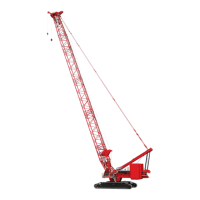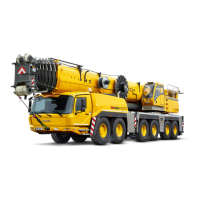Manitowoc Published 09-09-16, Control # 229-09 10-43
MLC650 SERVICE/MAINTENANCE MANUAL ACCESSORIES
VPC Counterweight Tray Extension
See Figure 10-34 for the following.
When the CCM-10 control module receives an extend tray
command (either from the setup remote or from the on-board
computer control), the CCM-10 control module sends a
command to the IOLC33 control module to begin ramping up
the pulse width modulation (PWM) duty cycle to the B-side
solenoid of the pump 7 electronic displacement control
(EDC).
At the same time, the CCM-10 control module sends a
command to the IOLC31 control module to disengage the
tray motor brakes. The IOLC31 control module then sends a
24 V
DC
output voltage to the brake release solenoid valve
(7), energizing the solenoid. The solenoid valve shifts
position, routing hydraulic fluid to the tray motor brakes,
releasing the brakes.
When movement of the tray is detected, the VPC warning
lights illuminate and the VPC alarm activates.
Increasing the PWM duty cycle increases the pump
swashplate angle, which increases the flow from the B-side
of the pump to the B-side of the right tray motor and the A-
side of the left tray motor. If the crane is equipped with the
VPC-MAX option, hydraulic fluid flows from the pump 7,
through the hot oil shuttle valve (1) and the VPC 1/VPC 2
diverter valve (2), then to the tray motors. The diverter valve
is kept in the VPC 1 (default) position during tray motor
operation.
The tray motor speed sensors and pump 7 (port B) pressure
transducer (VPC actuator extend psi) provide the closed
loop feedback. The control algorithm uses this feedback to
adjust the pump flow while ramping up to and maintaining
the tray speed.
The VPC tray rear limit (maximum out) switch (2,
Figure 10-38
) is provided to stop movement of the tray
before it reaches the rear physical stop (1, Figure 10-38
).
When the CCM-10 receives a stop tray command, the
CCM-10 control module sends a command to the IOLC31
control module to engage the brakes. The IOLC31 control
module then sends a 0 V
DC
output voltage to the brake
release solenoid valve, de-energizing the solenoid. The de-
energized solenoid causes the solenoid valve to return to the
default position, allowing the hydraulic fluid in the brake
cylinders to flow through the brake release solenoid valve,
then back to the tank. The reduced hydraulic pressure allows
spring force to apply the tray motor brakes.
At the same time, the CCM-10 sends a signal to the IOLC33
control module to ramp down the PWM duty cycle to the
pump 7 EDC, stopping all flow to the tray motors. When the
tray movement is stopped, the VPC warning lights and
alarms are deactivated.
VPC Counterweight Tray Retraction
See Figure 10-34 for the following.
When the CCM-10 control module receives a retract tray
command (either from the setup remote or from the on-board
computer control), the CCM-10 control module sends a
command to the IOLC33 control module to begin ramping up
the PWM duty cycle to the A-side solenoid of the pump 7
EDC.
At the same time, the CCM-10 control module sends a
command to the IOLC31 control module to disengage the
tray motor brakes. The IOLC31 control module then sends a
24 V
DC
output voltage to the brake release solenoid valve
(7), energizing the solenoid. The solenoid valve shifts
position, routing hydraulic fluid to the tray motor brakes,
releasing the brakes.
When movement of the tray is detected, the VPC warning
lights illuminate and the VPC alarm activates.
Increasing the PWM duty cycle increases the pump
swashplate angle, which increases the flow from the A-side
of the pump to the A-side of the right tray motor and the B-
side of the left tray motor. If the crane is equipped with the
VPC-MAX option, hydraulic fluid flows from the pump 7,
through the hot oil shuttle valve (1) and the VPC 1/VPC 2
diverter valve (2), then to the tray motors. The diverter valve
is kept in the VPC 1 (default) position during tray motor
operation.
The tray motor speed sensors and pump 7 (port A) pressure
transducer (VPC actuator retract psi) provide the closed loop
feedback. The control algorithm uses this feedback to adjust
the pump flow while ramping up to and maintaining the tray
speed.
The VPC tray forward limit (maximum in) switch (4,
Figure 10-38
) is provided to stop movement of the tray
before it reaches the forward physical stop (5, Figure 10-38
).
When the CCM-10 receives a stop tray command, the
CCM-10 control module sends a command to the IOLC31
control module to engage the brakes. The IOLC31 control
module then sends a 0 V
DC
output voltage to the brake
release solenoid valve, de-energizing the solenoid. The de-
energized solenoid causes the solenoid valve to return to the
default position, allowing the hydraulic fluid in the brake
cylinders to flow through the brake release solenoid valve,
then back to the tank. The reduced hydraulic pressure allows
spring force to apply the tray motor brakes.
At the same time, the CCM-10 sends a signal to the IOLC33
control module to ramp down the PWM duty cycle to the
pump 7 EDC, stopping all flow to the tray motors. When the
tray movement is stopped, the VPC warning lights and
alarms are deactivated.

